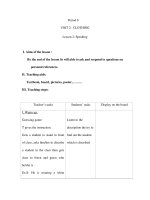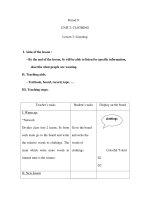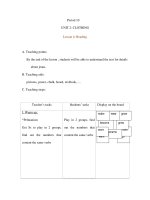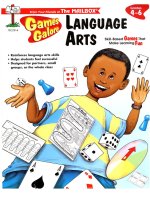4 6 crossing the nation by rail
Bạn đang xem bản rút gọn của tài liệu. Xem và tải ngay bản đầy đủ của tài liệu tại đây (2.83 MB, 10 trang )
Fascinating Facts
• In the 1820s many of the nation’s railcars were
pulled along their tracks by teams of horses.
• The city of Cheyenne, Wyoming, was built by
Union Pacific workers as a place to live while
working in the area.
• When trains first became popular, some doctors
warned that riding them at such fast speeds was
not healthy.
Genre
Nonfiction
Comprehension Skill
Sequence
Text Features
• Map
• Sidebar
• Captions
Scott Foresman Social Studies
ISBN 0-328-14865-2
ì<(sk$m)=beigfd< +^-Ä-U-Ä-U
As the United States began to spread
westward in the 1800s, a railroad was built
that would reach from coast to coast. In this
book you will read about the challenges that
this enormous project faced and how they
were overcome.
Write to It!
Think about what your daily life would
have been like if you worked to help build
the transcontinental railroad. Write a short
journal entry describing your day. Be sure
to include challenges you face as well as
successes.
Vocabulary
transcontinental railroad
transportation
engineer
Write your journal entry on a separate sheet
of paper.
gold rush
immigrant
Maps
MapQuest, Inc.
Photographs
Every effort has been made to secure permission and provide appropriate credit for photographic material. The publisher deeply
regrets any omission and pledges to correct errors called to its attention in subsequent editions.
ISBN: 0-328-14865-2
Copyright © Pearson Education, Inc.
All Rights Reserved. Printed in the United States of America. This publication is protected
by Copyright, and permission should be obtained from the publisher prior to any prohibited
reproduction, storage in a retrieval system, or transmission in any form by any means,
electronic, mechanical, photocopying, recording, or likewise. For information regarding
permission(s), write to: Permissions Department, Scott Foresman, 1900 East Lake Avenue,
Glenview, Illinois 60025.
1 2 3 4 5 6 7 8 9 10 V0G1 14 13 12 11 10 09 08 07 06 05
Unless otherwise acknowledged, all photographs are the property of Scott Foresman, a division of Pearson Education.
Offices:
Glenview,
Illinois
• Parsippany,
New Jersey
• New York, New York
Photo locators denoted asEditorial
follows: Top
(T), Center
(C), Bottom
(B), Left
(L), Right (R) Background
(Bkgd)
Opener: ©Bridgeman Art Sales
Library Offices: Needham, Massachusetts • Duluth, Georgia
2 ©The Granger Collection, NY
Coppell,
Texas • Sacramento, California • Mesa, Arizona
4 ©Bettmann/Corbis
5 ©Corbis
6 ©K.J. Historical/Corbis
9 ©Bettmann/Corbis
10 ©Bettmann/Corbis
15 ©Huntington Library/SuperStock
• Glenview, Illinois
Roads West!
In May 1869, people all across the United States
were celebrating. After six years of hard work, the
nation’s first transcontinental railroad was
completed. People who wanted to travel across the
country could now do so in ten days or less.
Today people have many choices about how to travel
from coast to coast. Many choose to fly because that is
the fastest way. Others drive their cars, take a bus, or
go by train.
For most of the 1800s, however, people had only a few
ways to travel to the West. They could sail around the
tip of South America or to Panama and back up along
the Pacific coast, or they could travel across the country
by covered wagon. These forms of transportation took
many months. They were also expensive and dangerous.
When the transcontinental railroad was completed,
an American dream had come true.
2
3
The Push for a
Transcontinental Railroad
The 1830 contest between the steam-driven Tom Thumb
and a railcar pulled by a horse was a historic race. Soon
new railroads would start to replace horses.
Rails in the United States
The history of the railroad in the United States
began in the 1820s. The first rail lines were built
across the East Coast because this was where most
large cities were located at the time. Even in cities,
however, the horse was still the most common form of
transportation.
In 1830 a railcar called the Tom Thumb raced against
a horse-drawn railcar. The Tom Thumb was not pulled
by a horse—it had a steam engine. The Tom Thumb lost
the race when its engine broke. Even so, engineers
were convinced that railroads would soon replace horses.
4
The United States was growing and changing in the
1800s. After winning a war against Mexico in 1848, the
United States gained more land in the Southwest. In
1849 thousands of people hurried to California during
the gold rush. California became a state the next year.
At first, most people thought that the idea of a
transcontinental railroad was foolish. The United
States only had about one thousand miles of railroad
tracks in 1835. As the country continued to spread
west, so did the rail lines. In time many people agreed
that a railroad that crossed the nation was a good idea.
In 1853 the government sent engineers to study five
different possible routes. Leaders in Congress argued
about which was the best route, but a railroad engineer
in California named Theodore Judah took action.
In 1861 Judah convinced four California
businesspeople to form the Central Pacific
Railroad. Known as the “Big Four,” the
men who owned this company went to
Congress. They announced that they
were ready to start building the
transcontinental railroad.
Leland Stanford was one of the
“Big Four.” He was a California
businessperson and a state governor.
5
This postcard shows the first
engine to operate on the
Central Pacific Railroad out
of Sacramento, California.
The Transcontinental Railroad
In 1862 the government passed the Pacific Railway
Act. This gave the Central Pacific the right to lay
tracks eastward from Sacramento, California. The
government also created the Union Pacific Railroad.
This new company was to lay tracks heading westward.
The two lines would meet somewhere along the route.
The Central Pacific held a groundbreaking ceremony
in Sacramento in January 1863. Railroad officials made
speeches. Workers then dug their shovels into the ground.
The building of the transcontinental railroad had begun!
At first progress heading east from Sacramento was
slow. Central Pacific workers had built only fifty-five
miles of track by September 1865.
6
Laying the Tracks
Engineers chose the route that the railroad
would take, and workers cleared the path of trees
and stones. Workers then built the roadbed, or the
surface the railroad would ride on.
Once the roadbed was ready, huge groups
of workers laid the tracks. First they planted
railway crossties, or wooden supports, firmly
into the ground. They then placed two long iron
rails parallel across the crossties. Finally they
hammered the rails into the crossties with spikes.
7
Working on the Railroad
The Sierra Nevada
At first the Central Pacific had a hard time finding
workers. The work was difficult and dangerous.
Many laborers wanted more than thirty-five dollars a
month—a lot of money back then. By early 1865 only a
few hundred Irish immigrants had been hired by the
Central Pacific.
As a solution to this problem, the Central Pacific
hired Chinese immigrants. Fifty new workers arrived at
the railroad camps in the summer of 1865. While at first
the other workers did not welcome them, many Chinese
proved to be skilled, hardworking, and courageous.
Soon the Central Pacific hired more Chinese
immigrants from San Francisco. They also asked
agents in China to send even more workers. By the
time the railroad was complete, about ten thousand
Chinese immigrants had done most of the labor.
The Central Pacific crews faced their most difficult
job after they left Sacramento. They had to lay tracks
across the Sierra Nevada, with peaks that loomed
thousands of feet high.
Working six days a week, crews carved roadbeds out
of steep mountainsides. They had to blow up cliffs and
cut passages through rock. They also dug fifteen tunnels
through the mountains. Because they had no modern
equipment, workers used picks, shovels, axes, animals,
wheelbarrows, and gunpowder to do the work.
Thousands of workers on the
transcontinental railroad
were Chinese immigrants.
8
9
During the winter
of 1866–1867,
snowslides killed
dozens of workers.
Work on the Union Pacific
A Harsh Winter
Central Pacific workers were drilling tunnels near
the top of a mountain pass when the winter of 1866
hit. For the next few months, crews braved freezing
temperatures, piles of snow, and dozens of storms. One
blizzard lasted for thirteen days!
That winter, workers lived in tunnels underneath the
snow or in shacks on the mountainside. Work continued
around the clock, but the crews could only build about
eight inches of track each day.
10
Progress on the Union Pacific line went even more
slowly. Omaha, Nebraska, had been chosen as the
starting point for the rail lines heading west. The Civil
War, however, delayed work until 1865.
After the war ended, crews of former soldiers, freed
African Americans, and European immigrants laid
tracks westward across the flat prairie.
The Union Pacific’s biggest problem came from
American Indians, or Native Americans. The railroad
tracks ran through American Indian buffalo hunting
grounds. The American Indians tried to keep the train
away by attacking the crews. United States soldiers
were sent to the Great Plains to guard the crews, and
the “iron roads” kept moving westward.
11
Racing to the Finish
The End of the Race
In 1868 the Central Pacific line came down from the
Sierra Nevada. Both companies were now on flat land.
Workers rushed to complete the most track—and to
earn as much money as possible.
There was a problem, however. The two railroad
companies had never chosen a meeting point for the
two sets of tracks. By the spring of 1869, each company
had cleared roadbeds that did not connect. In fact, the
two lines ran past each other, missing by more than one
hundred miles.
President Andrew Johnson and Congress forced
officials from the two companies to find a solution.
Officials picked a spot where the tracks would join.
They chose Promontory, Utah.
The crews of each company wanted to reach
Promontory first. This race fascinated people all
over the country. They eagerly followed the railroad’s
progress, mile by mile, in the newspapers.
The race to the finish made crews from both
companies work at top speed. Central Pacific workers
laid six miles of track in a single day. Then Union
Pacific crews laid seven miles of track in a single day.
On April 28 a Central Pacific crew worked from
sunrise until seven o’clock at night. It set a record by
laying more than ten miles of track. Two days later
Central Pacific crews reached Promontory and put
down their tools. They had won the race to the finish.
The First Transcontinental Railroad, 1869
CANADA
tr
Ce n
al
P a cific
Uni
o n Pa c
i f ic
Omaha
Sacramento
San
Francisco
N
MEXICO
0
0
12
250
250
500 Miles
500 Kilometers
13
Sometimes large valleys
were filled in with
dirt to lay the roadbed
of the railroad track.
Other times trestles,
or wooden supporting
structures, were built.
The Big Day
Union Pacific workers reached Promontory one day
after the Central Pacific. The railroad was almost
complete. In six years the companies had built 1,776
miles of track.
A big celebration was planned to mark the event. On
May 10, 1869, reporters, workers, and special guests
met at Promontory. Only one more spike was needed to
connect the two lines.
Leland Stanford, the president of the Central Pacific,
strode up to the rails. Using a silver hammer, he swung
at a specially made solid gold spike—and missed. Then
Dr. Thomas C. Durant, head of the Union Pacific, took a
try. He missed too!
A few moments later one of the workers hammered
in the last spike. The crowd cheered, and the news was
announced: “Done!” Around the country, people celebrated
the event with speeches, parades, and bell ringing.
14
A New Era Begins
The transcontinental railroad was finally open for
business. Many people took the trip across the country.
The journey lasted for eight to ten days. Passengers
could sleep in comfortable built-in beds, eat in the
dining cars, and buy candy and magazines.
The nation had made its dream of spreading from
coast to coast come true. A new era now began. The
railroad opened the West to tourists, travel reporters,
and job seekers. In later years several railroads
would cross the continent. Soon trains would connect
communities, large and small, all over the United States.
15
As the United States began to spread
westward in the 1800s, a railroad was built
that
would reach from coast to coast. In this
Glossary
book you will read about the challenges that
engineer a person who uses scientific and
this enormous project faced and how they
mathematical ideas to design, make, and run
were overcome.
structures and machines
Write to It!
Think about what your daily life would
have been like if you worked to help build
the transcontinental railroad. Write a short
journal entry describing your day. Be sure
to include challenges you face as well as
successes.
gold rush the sudden movement of many
Vocabulary
people to an area
where gold has been found
transcontinental
railroad
immigrant
a person who comes
to live in a
new land
transportation
transcontinentalengineer
railroad a railroad that
crosses a continent
gold rush
transportation the moving of goods, people,
immigrant
or animals from one place to another
Write your journal entry on a separate sheet
of paper.
Maps
MapQuest, Inc.
Photographs
Every effort has been made to secure permission and provide appropriate credit for photographic material. The publisher deeply
regrets any omission and pledges to correct errors called to its attention in subsequent editions.
Unless otherwise acknowledged, all photographs are the property of Scott Foresman, a division of Pearson Education.
ISBN: 0-328-14865-2
Photo locators denoted as follows: Top (T), Center (C), Bottom (B), Left (L), Right (R) Background (Bkgd)
Copyright © Pearson Education, Inc.
All Rights Reserved. Printed in the United States of America. This publication is protected
by Copyright, and permission should be obtained from the publisher prior to any prohibited
reproduction, storage in a retrieval system, or transmission in any form by any means,
electronic, mechanical, photocopying, recording, or likewise. For information regarding
permission(s), write to: Permissions Department, Scott Foresman, 1900 East Lake Avenue,
Glenview, Illinois 60025.
1 2 3 4 5 6 7 8 9 10 V0G1 14 13 12 11 10 09 08 07 06 05
16
Opener: ©Bridgeman Art Library
2 ©The Granger Collection, NY
4 ©Bettmann/Corbis
5 ©Corbis
6 ©K.J. Historical/Corbis
9 ©Bettmann/Corbis
10 ©Bettmann/Corbis
15 ©Huntington Library/SuperStock









